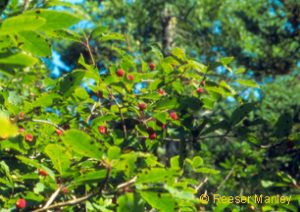Bulletin #2573, Native Trees and Shrubs for Maine Landscapes: Mountain Holly (Nemopanthus mucronatus)
Developed by Marjorie Peronto, Associate Extension Professor, University of Maine Cooperative Extension; and Reeser C. Manley, Assistant Professor of Horticulture, University of Maine.
For information about UMaine Extension programs and resources, visit extension.umaine.edu.
Find more of our publications and books at extension.umaine.edu/publications/.
Go native!
This series of publications is the result of a five-year research project that evaluated the adaptability of a variety of native trees and shrubs to the stresses of urban and residential landscapes in Maine. Non-native invasive plants pose a serious threat to Maine’s biodiversity. Plants such as Japanese barberry, shrubby honeysuckle, and Asiatic bittersweet, originally introduced for their ornamental features, have escaped from our landscapes, colonizing natural areas and displacing native plants and animals. By landscaping with native plants, we can create vegetation corridors that link fragmented wild areas, providing food and shelter for the native wildlife that is an integral part of our ecosystem. Your landscape choices can have an impact on the environment that goes far beyond your property lines.
Description
Form: a delicate, multi-stemmed shrub with open, slender, twisted branches; often forms thickets
Size: 6 to 10 feet tall, half as wide
Ornamental characteristics:
- blue-green summer foliage on purple petioles (slender stems that support leaf blades)
- bright red, solitary berries hang from long, threadlike pedicels (stalks that support the fruiting organs) in summer
- lemon yellow fall foliage
Landscape Use
Mountain holly can often be found growing in wet areas next to its close relative, winterberry holly (Ilex verticillata), surrounded by yellow birch (Betula alleghaniensis) and thickets of hazel alder (Alnus rugosa). It can be naturalized in wet woodland landscapes, where it will form dense colonies. You can site smaller groupings or even single specimens in a shady garden spot that offers a cool, moist root zone.
The blue-green foliage of mountain holly is the perfect foil for its bright red, velvet-textured berries. Unlike winterberry holly, the berries of Nemopanthus mucronatus do not persist into winter but are eaten by migrating songbirds in autumn. Thus mountain holly is an important native food source, ensuring that these birds have sufficient energy to complete their long flights.
Because N. mucronatus is a dioecious species, only female plants will bear the ornamental berries. However, you should plant at least one male plant in the landscape to ensure adequate pollination for abundant fruit.
Culture
Hardiness: USDA zone 4
Soil requirements: tolerant of a wide variety of soils
Light requirements: full sun or shade
Stress tolerances:
soil compaction — unknown
pollution — unknown
deicing salts — unknown
urban heat islands — intolerant
drought — unknown
seasonal flooding — tolerant
Insect and disease problems: infrequent
Wildlife Value
Unlike winterberry holly, mountain holly loses its berries early in the fall when the first wave of migrating songbirds stops over for a night of rest and feasting. By morning, both berries and birds are gone. Frequent songbird consumers include eastern bluebirds, hermit and wood thrushes, American robins, catbirds, northern mockingbirds, brown thrashers, cedar waxwings, and white-tailed sparrows. Raccoons and white-footed mice enjoy the fruits and seeds.
Maintenance
Irrigation: Water shrubs regularly for at least one year after planting. Apply 1 inch of water over the root zone once a week until leaves fall in autumn: in general, a shrub’s root zone extends twice as wide as its canopy. Once established, plants should survive even when no rain falls for up to two weeks. Keep soil moist by watering thoroughly once per week when needed.
Fertilization: Landscape trees and shrubs should not be fertilized unless a soil test indicates a need. Correct soil pH, if necessary, by amending the backfill soil. No nitrogen fertilizer should be added at planting or during the first growing season.
To learn more about native woody plants
Visit the Eastern Maine Native Plant Arboretum at University of Maine Cooperative Extension’s Penobscot County office, 307 Maine Avenue in Bangor. Established in 2004, the arboretum displays 24 different native tree and shrub species that can be used in managed landscapes.
Reviewed by Cathy Neal, Extension professor, University of New Hampshire Cooperative Extension.
Photos by Reeser C. Manley.
Illustration by Margery Read, Extension Master Gardener.
This series of publications and the associated research were made possible in part by the Maine Forest Service’s Project Canopy.
Information in this publication is provided purely for educational purposes. No responsibility is assumed for any problems associated with the use of products or services mentioned. No endorsement of products or companies is intended, nor is criticism of unnamed products or companies implied.
© 2008
Call 800.287.0274 (in Maine), or 207.581.3188, for information on publications and program offerings from University of Maine Cooperative Extension, or visit extension.umaine.edu.
In complying with the letter and spirit of applicable laws and pursuing its own goals of diversity, the University of Maine System does not discriminate on the grounds of race, color, religion, sex, sexual orientation, transgender status, gender, gender identity or expression, ethnicity, national origin, citizenship status, familial status, ancestry, age, disability physical or mental, genetic information, or veterans or military status in employment, education, and all other programs and activities. The University provides reasonable accommodations to qualified individuals with disabilities upon request. The following person has been designated to handle inquiries regarding non-discrimination policies: Director of Equal Opportunity and Title IX Services, 5713 Chadbourne Hall, Room 412, University of Maine, Orono, ME 04469-5713, 207.581.1226, TTY 711 (Maine Relay System).





